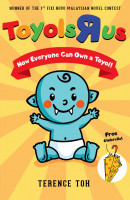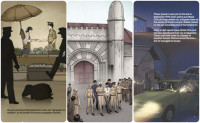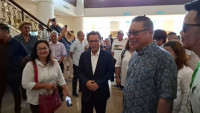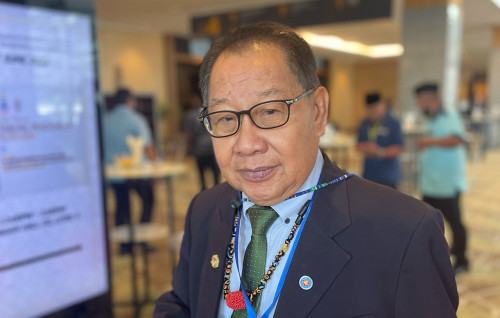‘THE Lockdown Chronicles’ is a collection of 17 short stories and two illustrations set during the Covid-19 pandemic and its slew of dislocations and confinements that characterised most of 2020. Edited by Viji Krishnamoorthy and Shireen Zainudin, the inspiration for the anthology was “to collect a Malaysian experience of these strange, unsettling, totally unprecedented times.”
A word that repeatedly came to mind upon reading and reflecting on ‘The Lockdown Chronicles’ is choice. The word became the plinth to my contemplation, holding up the many questions that emerged.
This review has spoilers.
At the risk of sounding petty, I found the choice of cover and title quite curious. With its gold embossed lettering on a plain royal blue cover and lime green ribbon in the middle that runs from front to back, the book looked more like a legal tome or a 1980s edition of ‘Gulliver’s Travels’ than a fiction anthology from 2021. It felt like a missed opportunity to draw in prospective readers at first sight.
While the book has lockdown in its title, quite a few of the stories adopt a looser interpretation. Readers who mentally prime themselves with expectations of stories situated squarely within the physical and emotional confines of the movement control orders (MCO) might be disappointed, for a few of the stories mention the lockdown and Covid-19 only in passing. Perhaps a less literal approach or open-ended title that references these times without naming a specific event would have synced name and substance better.
The sheer range of stories in a single collection was a pleasure to experience. A pensioner, a nine-year-old, a medical frontliner, a PR holder in limbo, and a slimy politician are but a few of the protagonists we encounter. Because the editors did not issue an open call for submissions, it is testament to their personal reach within the writing community that they were able to secure the participation of such a range of voices.
For a reader presented with this repertoire, the experience is akin to sampling morsels of food prepared by different chefs at a gastronomic showcase, reflecting individual influences while converging on a common curatorial thread.
Any collection of works by different authors will invariably reveal unevenness in craft. ‘The Lockdown Chronicles’ is no exception, although a dissection of key themes is also an opportunity for deeper interrogation by those interested in understanding the craft of writing and the bundle of frustration, curiosity and sparse logic that tags along with it.
The state of grappling with one’s own company challenges writers to explore deeper layers of interiority. When you don’t have face-to-face conversations or dialogue to push your story along, what devices are available to chart character progression and a narrative journey?
In ‘The Burglar,’ Mwaffaq Al-Hajjar opts for sentience. Holed up at home, his protagonist seeks reassurance from items lying around such as a pair of scissors, a mirror, a table, and a coffee machine. They all speak back. ‘The Burglar’ stands out as a story that does not centre the keyboard or screen as an intermediary for dialogue. In contrast, Nur Suraya and Michelle Soin’s characters interact primarily through a screen, but to different outcomes.
In ‘Roti Manis,’ Nur Suraya’s protagonist Lisa, a baker and Instagram influencer, has her online journey supplemented by accounts of baking sweet buns in her kitchen, which inject a tactile and more rounded delivery. On the other hand, the protagonist in Soin’s ‘The Batch of Covid-19,’ a university student forced to live out her final semester at home, does not have any interactions beyond the screen or her own mind.
The story goes in circles centred solely on her frustration, played out alternately in her journal and on the screen. While maybe reflective of spiralling anxiety and fodder for a hard-hitting social media update, for a short story the absence of an arc is unsatisfying and makes the character sound grating.
Three stories in ‘Lockdown Chronicles’ can be discussed under the topic of writing other voices. ‘Migrating to Community’ by Viji Krishnamoorthy, ‘MCO – MANicure Control Order’ by Marc de Faoite, and ‘Waiting’ by Hartini Zainudin are examples of writing where the authors take on the voice of segments of society who are less empowered along Malaysia’s socioeconomic schemata. de Faoite and Hartini’s protagonists are migrant workers and refugees, two groups who share a precarious legal status and bear the brunt of weaponised policies that nest conveniently within xenophobia in these times.
Writing fiction from the vantage point of marginalised groups which one doesn’t belong to poses its risks. It is easy to fixate on disempowering tropes simply because those are the types of narratives often appended to such communities by an unkind society. In addition, unwittingly lazy narratives betray the fact that the author isn’t in fact from the communities whose voices they assume. de Faoite and Hartini are able to add complexity to their character’s thoughts, not shying to lay bare the unpleasant and inhumane elements, but also not condemning their characters to fall under their weight.
A migrant worker feted by marriage proposals from her customers in a makeshift nail parlour or a young boy dreaming of life in a new country while in detention cast light on hoping for a brighter dawn, which we can all empathise with. The authors demonstrate that we don’t have to be at the mercy of pat endings or farcical positivity to glimpse humanity in times of pain.
Ammu, a single mother living in poverty in Kuala Lumpur, is the protagonist in ‘Migrating to Community.’ The story is a nice enough read, and that Krishnamoorthy’s departure point is empathy is not in doubt. However, reading it produced the familiarity of a story one has heard many times before, of a woman living in poverty being at the mercy of an abusive husband, a cruel landlord, and punishing hunger.
I would argue that more justice could be done to the story by giving glimpses of Ammu that don’t just position her as a target of cruelty. A fleeting hope, a moment of joy or any similar layer of agency as an individual who surely, even if ever so slightly, is more than what is inflicted on her could have resulted in a more fleshed-out character. That said, the plot twist ending did leave me tingling.
The question of choice is pared to its barest in two stories, ‘The Dao of Carpenter Street’ by Alasdair Clayre and ‘River’ by Sujatha Sekhar Naik. They merit joint mention as stories with protagonists that are non-verbal in real life, namely a cat and river respectively.
When authors choose such unconventional characters, there is an expectation that the pay-off for readers is so large that the authors had no choice but to choose these characters, and would put in the extra work of making them come alive that such a decision entails. Simply put, if your character could be a human and thus more relatable to a human reader from the start, why make it a cat?
Clayre’s choice of Oscar, a cat protagonist is quite obviously due to the story being set in Kuching, alongside the imagery of cat and spiritual guardian that are present. Still, the character development appeared disjointed from the set-up. Maybe all it needed was more thought of what it means to inhabit the mind and body of the animal in the world of the story. The mannerisms and motivations of a cat did not come through, dishing out an image of Oscar as sometimes anthropomorphic but sometimes not. As nice as the idea dovetails with Kuching imagery, were readers expected to be satisfied with a rendition of a cat that watched soap operas on Netflix and could chuckle?
The river in ‘River’ is mostly a bystander and observer of the unfolding tragedy experienced by human characters. Again, beyond an initial spark of intrigue at the clever premise, I thought there was nothing in the story that made it necessary for the protagonist to be a river. In fact, I still wonder whether it wanted to be an ominous tale decrying environmental degradation, or one about tragedy in a time of Covid. The latter felt awkwardly grafted onto the former.
Having unconventional characters that don’t deliver the goods as narrative movers is like meeting someone at a party dressed spectacularly in captivating garb, only to realise an hour later that they cannot carry a meaningful conversation.
If reading a book is like having a conversation with the authors, ‘The Lockdown Chronicles’ will definitely elicit a lengthy and likely impassioned exchange within any reader. Its diversity of characters and settings makes sure of this. The stories are of a moment in time. And reading the book during another iteration of the MCO and treating a few of the stories in the collection as works in an imaginary writing workshop is a response that may be uniquely mine. Readers might catch themselves questioning choices in the book here and there, but consider it an exercise in understanding your own responses to literature and path to becoming a self-aware reader, and all will be fine. – The Vibes, February 7, 2021




.jpg)


















